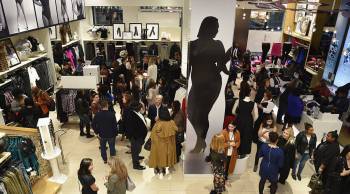
The growing push for size inclusivity in fashion faces some obstacles
The growing push for size inclusivity in fashion faces some obstacles

The global plus-size women’s clothing market is expected to reach “a market value of over $264.4 billion in 2027, while the cumulative growth opportunity […] over the forecast period is $1570 billion,” according to Credence Research.
While fashion clothing brands are taking steps to be size-inclusive, they’re facing some challenges. Old Navy, for example, launched a program, Bodequality, however sales started to decline after the launch. Elizabeth Segran, senior staff writer at Fast Company, covered that in a recent report.
“Marketplace” host Kai Ryssdal spoke with Segran about the fashion industry and plus-size inclusivity. The following is an edited transcript of their conversation.
Kai Ryssdal: What went wrong with Old Navy and Bodequality?
Elizabeth Segran: Oh, my goodness. Well, just to start with last August, Old Navy said that it was unveiling what it described as its biggest launch in the entire history of the brand. And basically, what it said was that it was going to make every single style of clothing in its line from size 0 to size 30. Most fashion brands specialize in making clothes that only go up to size 16. And there are some brands that go into the plus size, which only specializes in making clothes [size] 18 and up. So it was a really big deal. Because, until now, if you went shopping with a friend of yours, and you’re a size 8 and your friend was a size 18, you couldn’t actually shop in the same stores. And for a long time plus-size women have said that they felt really marginalized by the entire fashion industry,
Ryssdal: So if Old Navy had picked this sweet spot, as it were — and I’ll get to this with some other companies in a minute — but if they had said: “Let’s start in the mid range of all women, instead of everybody, zero to 30,” that might have worked, right?
Segran: Yes, so the problem was that they couldn’t tell which sizes to put in which stores. When you went into an Old Navy store, there were tons of clothes in the middle of sizes that were gone because everybody had bought them. And, basically, there was a lot of inventory that was too small or too large.
Ryssdal: So can we talk about women in this economy and what they shop for, size wise, when they go into a store? I’m sure somebody knows — and it’s probably you, actually, in this conversation — what the median woman is in this economy, and how you engineer size distribution when you’re a buyer, and you’re trying to figure out what to do.
Segran: So what’s really interesting is that the average woman in the United States is a size 18. And plus-size women make up more than half the market. And yet, plus size clothes only make up 19% of all apparel on the market. The fashion brands are not actually meeting the needs of their customers.
Ryssdal: This seems just wild because companies are leaving money on the table, the business opportunity in the plus sizes would seem to be sizable.
Segran: It’s a huge wasted opportunity. And part of the problem is that it takes a lot of skill to be able to make a garment that fits really well in a size zero as well as a size 30. And so brands really haven’t taken the time to invest in this kind of technology. But Old Navy did.
Ryssdal: Oh, wait, say more about that.
Segran: So Old Navy spent two years developing all of this really cool design technology, so that everything that they made would fit perfectly, no matter what size you were. And they also re-engineered their stores so that women could shop based on the style of the garment rather than having to go to a special plus-size section if they wanted to buy a particular piece of clothing. And this was a really important thing for them to do, to push the industry forward when it comes to size inclusivity because most brands are not doing this.
Ryssdal: OK, so look. Old Navy has tried this, it didn’t work spectacularly and, point of fact, it cost the president and CEO of the Old Navy line her job. It hit Gap really, really hard. Now what happens with this — what could be a really profitable segment of the plus women’s market — if Old Navy is out?
Segran: So Old Navy has said that it’s scaling back the program a little bit. But I think what’s really important for Old Navy is that it actually takes the time to figure out, you know, all of this back-end data that it needs so that it can make these smarter decisions. If they can figure out some of these technical issues, then they’re going to be far, far more successful. It’s just about growing pains.
There’s a lot happening in the world. Through it all, Marketplace is here for you.
You rely on Marketplace to break down the world’s events and tell you how it affects you in a fact-based, approachable way. We rely on your financial support to keep making that possible.
Your donation today powers the independent journalism that you rely on. For just $5/month, you can help sustain Marketplace so we can keep reporting on the things that matter to you.


















